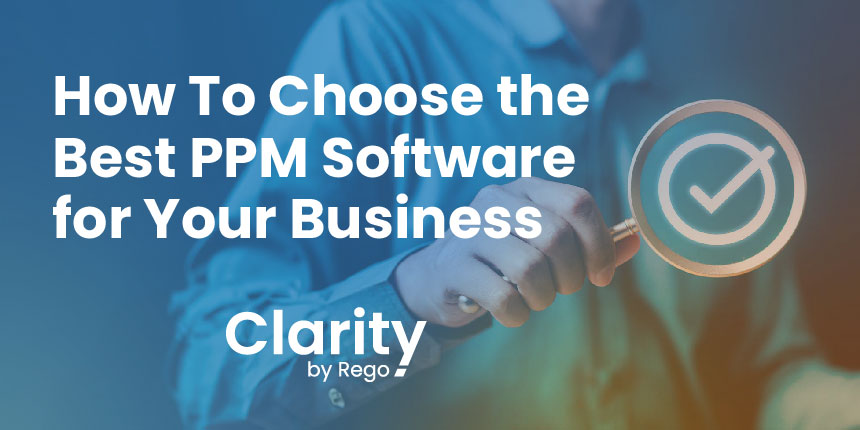by Clarity by Rego
Share

Using DIY processes and low-feature tools to manage projects can work for a lot of companies in the short term. But what happens as your projects multiply and become more complex? At some point, as the inefficiencies of juggling multiple tools add up, the lack of cohesion and visibility begins to negatively affect planning, strategy, and profitability.
The good news is that there is a way to work smarter and manage projects more efficiently. With project portfolio management (PPM) software, not only can you manage all the moving parts of each project, but you can see everything that’s going on across your entire operation—all in one place. However, the sheer volume of PPM software available makes it difficult to distinguish which one is the best fit for your business. The key to selecting the best solution for your needs is knowing where to begin and what to look for. Here are a few questions that will put you in an optimal position to find a solution that can fulfill your team’s needs now and into the future.
What do I need from a PPM solution?
Before you can determine which PPM solution best meets your unique needs, you need to articulate what those needs are. Creating a list of your pain points and objectives will allow you to measure each solution against its ability to address your challenges and help you achieve your goals. This puts you in a better position to accelerate your search by quickly eliminating tools that don’t meet your criteria and focusing on a smaller pool of products that check the right boxes. From there, you can begin a more in-depth review of the capabilities that are most important to you. Making direct comparisons across solutions highlights any differences in functionality to help you determine which is the match.
How easy is it to adopt?
Obviously, any software is useless if people don’t use it. finding a user-friendly solution can go a long way to promoting adoption across your organization. However, ease of use means different things across different roles, teams, and companies, so assess how well a tool meets the needs of all of your end-users. Comparing the support and maintenance resources available is also important since vendors with strong partners tend to offer the most value, so find out if partners are available to provide additional guidance and support. Finally, a cumbersome implementation process can tank adoption before you’re even up and running. Understand the total effort rollout will require—including how long it will take, any external resources and supporting technologies required, and deployment options (SaaS delivery being the fastest, on average).
Can it adapt to the way you work?
Configurability requirements can vary by industry and the complexity of a company’s processes. Look for a solution that’s flexible enough to adapt to your organization’s specific needs. That starts with supporting a range of project methodologies (e.g., Agile, traditional, hybrid, etc.), so you have the option to choose the one that works best for each team and project. The degree to which a tool is configurable to the different work styles and needs of each user can also help accelerate adoption across teams. But be mindful of the difference between configuration and customization—ensure users can tailor the solution as needed without in-depth technical expertise.
Can it grow with your organization?
While selecting a PPM that meets your current project management needs is your first priority, you should also consider future growth in your decision-making. Some more niche tools can’t exceed specific thresholds or only offer limited functionality beyond a certain point. Take note of any restrictions around things like users, data, and analytics, as well as each solution’s versatility around things like managing different types of projects and expanding to new departments and use cases. Look for a solution that can right-size functionality to meet your needs now, with the capacity to scale with your organization and evolve to accommodate your changing demands.
How seamlessly does it integrate?
With any solution, pay close attention to the ease with which it can connect and communicate with the software you already use. The level of interoperability between a PPM and the rest of your application ecosystem can both accelerate implementation and streamline day-to-day management. The ability to easily share information and updates across systems while incorporating their existing tools enhances user experience and buy-in. Evaluate each solution’s capacity to blend with the applications your team relies on every day, including typical integrations and APIs.
Does it fit my budget?
Cost is certainly a significant consideration, so it’s essential to clearly understand and compare what each solution offers across pricing tiers. Things like available licensing options, who can access what functionality, and additional fees for supporting technologies can vary greatly—so you want to examine the details to ensure your comparisons are accurate. Ideally, this will be a long-term partnership, but be wary of solutions that require long-term commitments. Look for flexible, transparent pricing that doesn’t require a substantial investment upfront.
Evaluating PPM software doesn’t have to be a daunting, time-consuming task. Understanding the right questions to ask is a crucial first step toward making better, more informed decisions. For more in-depth strategic insights on selecting the right solution for your organization, check out our PPM Buyer’s Guide.
STAY IN THE LOOP
Get Notified of Updates.
Stay ahead of the curve by subscribing to our newsletter. Get the latest insights, strategies, and tools delivered straight to your inbox, and empower your business to achieve more.


